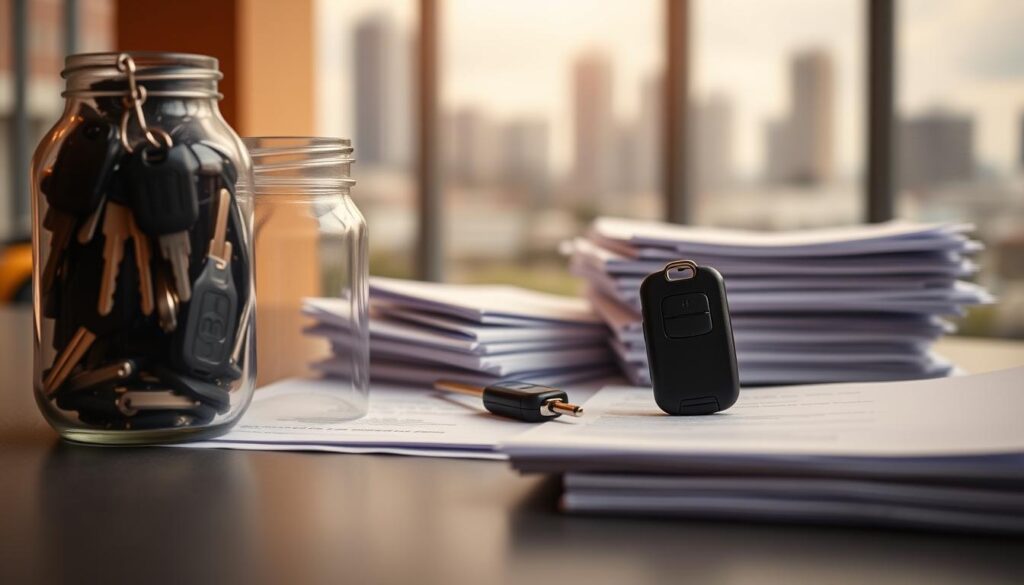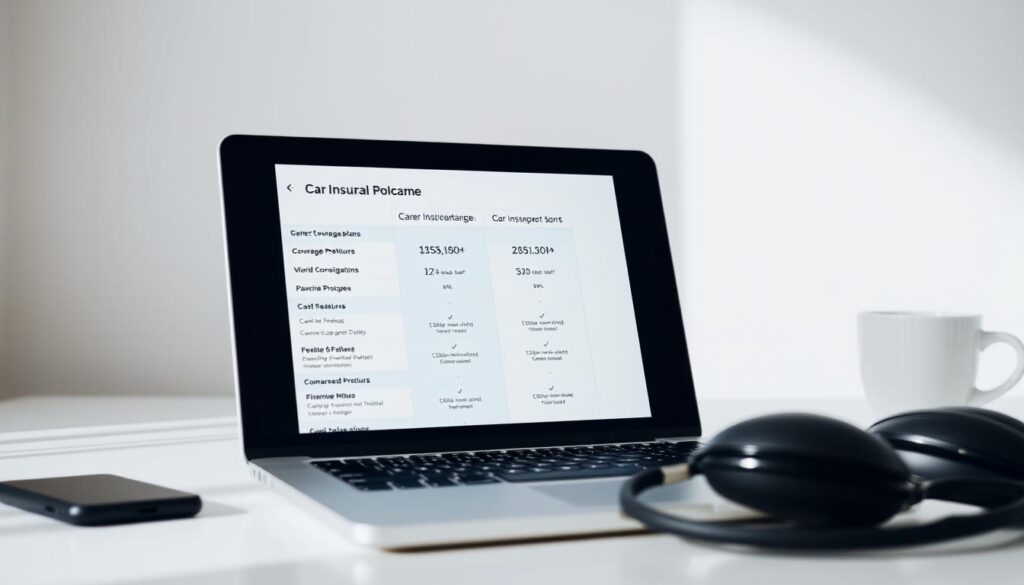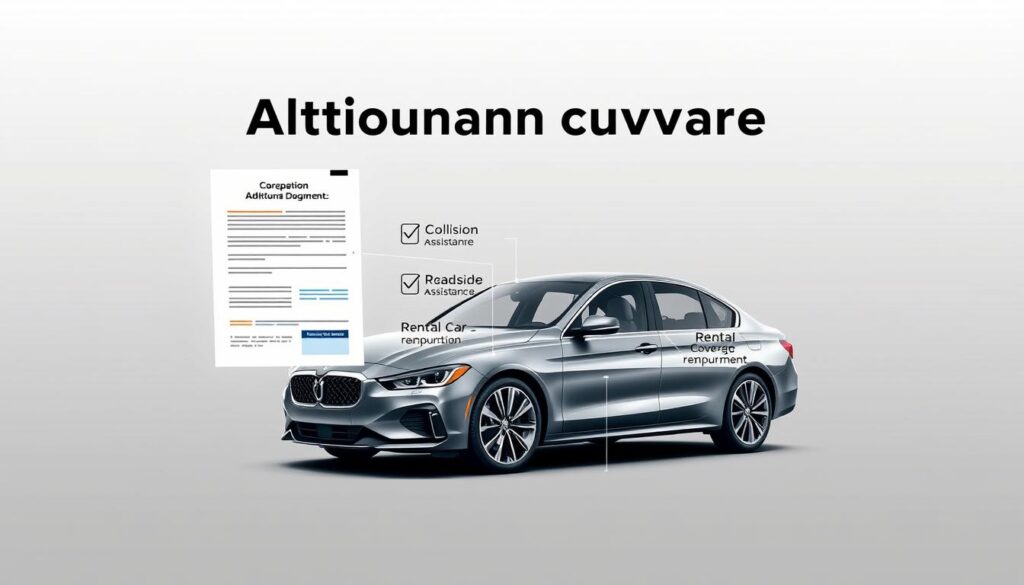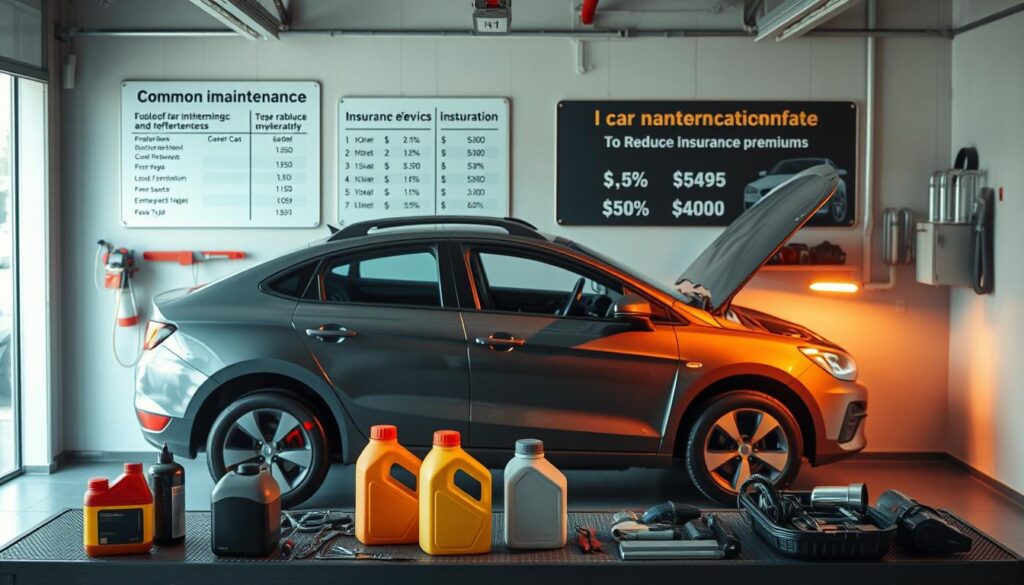Understanding car insurance can seem tough, but it’s doable with the right help. At Alexander Practice, we aim to share our knowledge. This way, individuals can make smart choices about their insurance.
Our detailed guide will cover the basics of car insurance. You’ll learn how to cut costs and grasp the industry’s complexities. With our advice, you’ll be ready to pick the right insurance for you.
Key Takeaways
- Knowing the basics of car insurance is key to making good choices.
- To lower car insurance costs, you need the right coverage and smart planning.
- Expert advice from Alexander Practice can guide you through car insurance’s complexities.
- A thorough guide is vital for finding the best car insurance.
- Smart decisions about car insurance can save you money and give you peace of mind.
Understanding Car Insurance Basics
Knowing the basics of car insurance is key for every driver. It’s not just a legal must in many places. It’s also a big financial shield against accidents or damage to your car.
What is Car Insurance?
Car insurance is a policy that protects you from financial losses in accidents or car damage. You pay premiums to the insurer. They agree to cover some costs of damages or liabilities.
Car insurance is like a financial safety net. It helps manage risk by covering potential financial losses. This way, you don’t face huge costs if something unexpected happens.
Why is Car Insurance Important?
Car insurance is crucial for many reasons. It’s a must in most states, and driving without it can lead to big penalties. It also offers financial protection against high repair costs, medical bills, and legal fees from accidents.
It also brings peace of mind. Knowing you’re covered can lessen driving stress and anxiety. It ensures you won’t be financially hit hard by unexpected road events.
Types of Car Insurance Coverage
There are many car insurance coverages, each for different risks. Knowing these can help pick the right policy for you.
| Type of Coverage | Description |
|---|---|
| Liability Coverage | Covers damages to others in an accident |
| Collision Coverage | Pays for damages to your vehicle in an accident |
| Comprehensive Coverage | Covers damages not related to accidents, such as theft or natural disasters |
| Personal Injury Protection (PIP) | Covers medical expenses for you and your passengers |
By grasping these basics, you can make better car insurance choices. It’s wise to check your policy often to see if it still fits your needs.
Key Terms in Car Insurance
To understand car insurance, knowing terms like premium, deductible, and coverage limits is key. These terms help you choose the right policy and might lower your car insurance cost.
Premium
Your premium is the cost of your car insurance policy. It’s paid monthly or yearly. Many things affect your premium, like your driving record, car type, and where you live.
For a lower premium, follow best car insurance practices. Keep a good credit score, add safety features to your car, and combine your insurance policies.
Deductible
The deductible is what you pay first when you file a claim. For example, if repairs cost $2,000 and your deductible is $500, you pay $500. Your insurance covers the rest, $1,500.
- Lower deductibles mean higher premiums, as the insurance company takes on more risk.
- Higher deductibles lower premiums but increase your costs when you file a claim.
Coverage Limits
Coverage limits are the max your insurance pays for a loss. It’s important to pick limits that protect your assets in a serious accident. Think about your finances and your car’s value when setting limits.
Here are some key points to consider for coverage limits:
- Make sure your liability coverage is enough to protect your assets.
- Choose comprehensive and collision coverage limits based on your car’s value.
- Check your coverage limits often to make sure they’re still right.
Understanding these terms helps you make better choices about your car insurance. This can lead to saving on your car insurance cost.
Factors Influencing Car Insurance Rates
Car insurance rates are not random. They are shaped by personal and vehicle-related factors. Knowing these can help you lower your insurance costs.
Driving History
Your driving history greatly affects your insurance rates. A clean record means lower premiums. It shows you’re a safe driver. But, accidents or tickets raise your rates, as you’re seen as riskier.
To keep a clean record, drive safely and follow the rules. Taking defensive driving courses can also lower your rates.
Vehicle Type
The type of vehicle you own impacts your insurance rates. Expensive or high-performance cars cost more to insure. But, cars with good safety ratings and lower values have lower premiums.
Think about insurance costs when buying a car. Some cars are in higher insurance groups because they’re expensive to repair or steal.
Location
Your location also affects your insurance rates. Urban areas have higher rates due to more accidents and theft. Rural areas have lower rates because of fewer risks. Areas prone to natural disasters also have higher premiums.
Here’s a comparison of how different factors can influence car insurance rates:
| Factor | Impact on Insurance Rates | Potential Actions |
|---|---|---|
| Driving History | A clean record lowers rates, while accidents or tickets increase them. | Drive defensively, take defensive driving courses. |
| Vehicle Type | Expensive or high-performance vehicles cost more to insure. | Consider insurance costs when buying a vehicle. |
| Location | Urban areas have higher rates than rural areas. | Understand local risks and adjust your coverage accordingly. |
By understanding these factors and taking proactive steps, you can lower your car insurance costs. It’s wise to regularly review your policy and adjust it as needed.
Types of Car Insurance Policies
Car insurance isn’t a one-size-fits-all solution; various policies cater to different needs and circumstances. Understanding these differences is key to selecting the right coverage for your vehicle.

Liability Insurance
Liability insurance is a fundamental component of car insurance, covering damages to others in an accident where you’re at fault. It includes bodily injury liability and property damage liability.
Collision Insurance
Collision insurance covers damages to your vehicle resulting from a collision, regardless of fault. This type of insurance is particularly valuable for newer or high-value vehicles.
Comprehensive Insurance
Comprehensive insurance provides coverage for damages to your vehicle not caused by a collision, such as theft, vandalism, or natural disasters. It’s an essential component of a comprehensive car insurance guide.
Uninsured/Underinsured Motorist Coverage
This type of coverage protects you if you’re involved in an accident with someone who doesn’t have insurance or doesn’t have enough insurance to cover the damages. It’s a critical aspect of a robust car insurance coverage plan.
By understanding the different types of car insurance policies, you can make an informed decision about your insurance needs. Whether you’re looking for basic coverage or a more comprehensive plan, there’s a policy designed to fit your circumstances.
Understanding Your Policy
To get the most out of your car insurance, it’s vital to understand your policy details. A car insurance policy is a legal contract between you and the insurance company. It outlines the terms and conditions of your coverage.
Reading Your Car Insurance Agreement
Reading your car insurance agreement might seem daunting. But it’s a crucial step in understanding your coverage. Look for sections that outline your coverage limits, deductibles, and any exclusions. Pay particular attention to the declarations page, which summarizes your policy’s key details.
Key elements to review:
- Coverage types and limits
- Deductibles and premiums
- Exclusions and limitations
Common Exclusions in Policies
Car insurance policies often have exclusions. These are situations or circumstances not covered by your policy. Common exclusions include damage caused by wear and tear, racing, or using your vehicle for commercial purposes without the appropriate coverage.
“Understanding what’s excluded from your policy can save you from unexpected surprises when filing a claim.”
How to File a Claim
Filing a claim can be straightforward if you have all the necessary information. Start by notifying your insurance company as soon as possible after an incident. Provide detailed documentation, including photos of the damage and any relevant police reports.
Tips for a smooth claims process:
- Document the incident thoroughly
- Keep records of all correspondence with your insurer
- Follow up on the status of your claim
Shopping for Car Insurance
Finding the best car insurance means comparing quotes and knowing about discounts. It’s important to look at all options to find a policy that fits your budget and needs.

Comparing Quotes
It’s key to compare quotes from different insurance companies. This helps you see which policy offers the best coverage and price. Make sure to give the same information to each company to compare fairly.
Key factors to consider when comparing quotes include:
- Coverage limits and deductibles
- Premium costs and payment options
- Additional features or services offered
- Customer service and claims handling reputation
Understanding Discounts
Insurance companies offer discounts that can lower your premiums. Knowing about these discounts can save you money. Discounts are given for safe driving, having multiple policies, good grades, and certain jobs or groups.
It’s important to ask about discounts when looking for car insurance.
“Insurance companies often provide discounts to drivers who demonstrate safe driving habits or bundle multiple policies. It’s worth asking about these opportunities when comparing quotes.”
Is Bundling Insurance Beneficial?
Bundling car and home insurance can be good for several reasons. It can make managing your insurance easier and might save you money. But, make sure it’s the best deal for you by comparing it to separate policies.
By comparing quotes, understanding discounts, and thinking about bundling, you can choose the right car insurance. This way, you get the coverage you need at a good price.
State Requirements for Car Insurance
It’s key for drivers to know the car insurance rules in their state. Insurance laws differ across the U.S. Knowing your state’s laws helps avoid fines and ensures you’re covered.
Minimum Coverage Requirements by State
Every state has its own car insurance rules. These rules often include liability insurance to cover damages in accidents. For example, some states require coverage for injuries and property damage.
Some states need at least $25,000 for injury coverage per person and $50,000 for each accident. It’s important to check your state’s rules to meet the minimums. Some states also require extra coverage like uninsured motorist or personal injury protection.
Penalties for Not Having Insurance
Driving without insurance can lead to big problems. Fines can be hundreds to thousands of dollars, depending on the state. Your license and car registration might also be taken away until you show proof of insurance.
The Insurance Information Institute says driving without insurance is a big deal. It can cause big financial and legal issues.
“The financial protection provided by car insurance is critical in the event of an accident, and driving without it can lead to financial ruin.”
Having the right car insurance is more than just following the law. It’s also a way to protect your wallet. The right coverage can save you from big expenses if you’re in an accident.
Additional Coverage Options
When looking at car insurance, it’s key to check out extra coverage options. These can give you more protection and peace of mind.
Some policies come with special features. For example, gap insurance helps if your car is totaled. It pays the difference between what you owe and the car’s value. This is great for those who finance or lease their cars.
Gap Insurance
Gap insurance protects you from financial loss if your car is totaled. Here’s how it works:
- If your car is totaled, insurance pays the car’s actual cash value.
- If you owe more than the car’s value, gap insurance covers the difference.
This insurance is very helpful for those with new cars. New cars lose value quickly.
Rental Car Coverage
Rental car coverage is another great option. It pays for a rental car while your car is being fixed. This is super helpful for those who use their cars a lot.
Key benefits include:
- It covers rental car costs while your car is being fixed.
- Some policies also cover other transportation costs, like public transport or ride-sharing.
Roadside Assistance
Roadside assistance helps in emergencies, like:
- Towing services.
- Fuel delivery.
- Lockout service.
- Tire changes.
This coverage is great for those who drive a lot or in areas with emergencies.
When thinking about these extra options, weigh the benefits against the costs. Alexander Practice car insurance insights say to think about your needs and situation. Decide which coverages are best for you.

In summary, options like gap insurance, rental car coverage, and roadside assistance can improve your car insurance. They offer more protection and convenience. Knowing about these options helps you make better choices for your insurance.
Tips for Reducing Your Car Insurance Costs
There are many ways to cut down on car insurance costs without losing coverage. Making a few simple changes and making smart choices can help you save money. This way, you can lower your premiums and keep more of your hard-earned cash.
Safe Driving Incentives
Driving safely is a top way to lower your insurance costs. Many companies give safe driving incentives for not filing claims or taking defensive driving courses. For example, a study by the National Highway Traffic Safety Administration shows that defensive driving courses can reduce accident rates.
Insurance companies like Geico and Progressive offer discounts for drivers who take these courses.
“Safe driving is not just about avoiding accidents; it’s about being proactive in reducing risks on the road,” said Jane Smith, an insurance expert.
By driving safely and avoiding accidents, you can greatly reduce your insurance costs over time.
Increasing Your Deductible
Another way to lower your insurance costs is by increasing your deductible. The deductible is what you pay when you file a claim. Choosing a higher deductible can lower your premium. But, make sure you can afford the deductible if you need to file a claim.
For instance, raising your deductible from $500 to $1,000 could save you up to 30% on your premium, according to some providers.
Regularly Reviewing Your Policy
It’s important to regularly review your car insurance policy. As your life changes, like moving or driving less, your insurance needs might too. Annual policy reviews help you adjust your coverage and premiums. It’s also a chance to look for new discounts or coverage options.
By following these tips and staying informed, you can effectively lower your car insurance costs. The goal is to find a balance between saving money and having enough coverage.
Maintaining Your Car to Lower Insurance Costs
Keeping your car in good shape is a best car insurance practice that can lower your insurance costs. Regular care ensures your car runs well and affects your insurance rates. Knowing how maintenance and safety features impact rates helps you save on insurance.
Importance of Vehicle Maintenance
Regular car care is key to avoiding accidents and claims. Simple tasks like oil changes, tire rotations, and brake pad replacements improve your car’s safety. Following the manufacturer’s maintenance schedule also prevents mechanical failures that could cause accidents.
Insurance companies see well-kept cars as safer to insure. A well-maintained car is less likely to be in an accident, which means lower insurance costs. Some insurers even give discounts for cars with safety features or regular maintenance records.

How Safety Features Impact Insurance Rates
Today’s cars come with many safety features to prevent or lessen accidents. These features, like ABS, ESC, lane departure warning systems, and advanced airbags, can greatly affect your insurance rates. They help prevent accidents or reduce damage in crashes.
Insurance companies offer discounts for cars with these safety features. These features can lower your insurance rates because they reduce claim risks. Here’s how different safety features can impact insurance rates:
| Safety Feature | Impact on Insurance Rates | Average Discount |
|---|---|---|
| Anti-lock Braking System (ABS) | Reduces risk of skidding and accidents | 5% |
| Electronic Stability Control (ESC) | Helps maintain vehicle control | 3-5% |
| Lane Departure Warning Systems | Prevents drifting into other lanes | 4-7% |
| Advanced Airbags | Reduces injury severity in collisions | 2-4% |
By keeping your car in good condition and adding safety features, you can stay safe on the road and save on insurance. It’s a car insurance advice that can help you get the most from your policy.
Understanding Claims Process
Navigating the car insurance claims process can be complex. But knowing what to do can help you get back on the road fast after an accident.
Steps to Take After an Accident
Right after an accident, make sure everyone is safe. Then, document the incident. We recommend these steps:
- Move to a safe location if possible
- Call the police to report the accident
- Exchange information with the other parties involved
- Document the scene with photos
- Notify your insurance provider as soon as possible
What to Expect During the Claims Process
After filing a claim, the insurance company will start an investigation. We can expect these stages:
- Assignment of an adjuster to your case
- Assessment of the damage
- Review of the policy coverage
- Determination of the claim’s validity
- Settlement or denial of the claim
Common Reasons Claims are Denied
Claims can be denied for several reasons, including:
- Incomplete or inaccurate information
- Policy exclusions
- Late filing
- Disputed liability
Understanding these reasons can help avoid them. This ensures a smoother claims process.
The Future of Car Insurance
The insurance world is changing fast. Autonomous vehicles and usage-based models are leading the way. These changes aim to make car insurance more personal and efficient.
Impact of Autonomous Vehicles
Autonomous vehicles (AVs) will change car insurance a lot. They might cut down on accidents caused by people. This could mean lower insurance costs.
But, AVs also bring new risks like cyber threats and who’s to blame in accidents. Insurers will have to create new policies and adjust prices for these risks.

Usage-Based Insurance Models
Usage-based insurance (UBI) is getting more popular. It uses devices or apps to track how you drive. This way, insurers can set prices based on your actual driving.
UBI can encourage safer driving and give discounts to those who drive well. As tech gets better, more insurers will use UBI.
Trends in Insurance Technology
Insurance tech, or insurtech, is changing car insurance in many ways. It includes AI for claims and blockchain for policy management. These innovations make things more efficient, cut costs, and improve how customers feel.
Some big trends in insurtech are AI for risk checks, blockchain for secure policies, and mobile apps for easier policy and claim management.
| Trend | Description | Potential Impact |
|---|---|---|
| Autonomous Vehicles | Vehicles with increasing levels of autonomy | Reduced accidents, new liability concerns |
| Usage-Based Insurance | Insurance pricing based on actual driving habits | More personalized premiums, safer driving incentives |
| Insurtech Innovations | Technological advancements in insurance | Improved efficiency, enhanced customer experience |
Looking ahead, car insurance will keep evolving. This is due to new tech and how people behave. At Alexander Practice, we believe it’s key for insurers and policyholders to stay up-to-date with these changes.
Frequently Asked Questions About Car Insurance
Exploring car insurance can be complex. It’s important to understand its many aspects. This knowledge helps drivers make better choices.
What to Do if You’re Underinsured?
Being underinsured means you don’t have enough coverage. If this happens, here’s what to do:
- Review your current policy to understand your coverage limits.
- Assess your financial situation to determine how much more coverage you can afford.
- Consult with your insurance provider to explore options for increasing your coverage.
How Does Car Insurance Work When Traveling?
Traveling with your car insurance can be tricky. Your policy usually follows the vehicle, not the driver. So, if you’re driving your own car, you’re covered. But, if you’re renting a car, you might need extra coverage from the rental company or your credit card.
Can You Insure a Leased Vehicle Differently?
Leasing a car requires specific insurance. Leasing companies usually want comprehensive and collision coverage. You can add these to your policy. Gap insurance is also a good idea, covering the difference if the car is totaled.
| Insurance Aspect | Leased Vehicle | Owned Vehicle |
|---|---|---|
| Comprehensive Coverage | Required by leasing companies | Optional but recommended |
| Collision Coverage | Required by leasing companies | Optional but recommended |
| Gap Insurance | Highly recommended | Not necessary unless you owe more than the vehicle’s worth |
We aim to clear up common car insurance questions. This should help you better understand and manage your insurance needs.
Myths and Misconceptions About Car Insurance
The world of car insurance is full of myths and misconceptions. These can affect your financial security. Many drivers believe things about their car insurance that aren’t true. This can lead to confusion and costly mistakes.
Debunking Common Car Insurance Myths
There are many myths about car insurance that need to be debunked. This will help you understand your coverage better.
- Myth: Red cars cost more to insure. Reality: The color of your car doesn’t affect your insurance rates. What matters more is the car’s make, model, and year.
- Myth: Your credit score doesn’t impact car insurance. Reality: In many states, insurance companies do use credit scores. A good credit score shows you’re financially responsible.
- Myth: Comprehensive coverage is unnecessary. Reality: Comprehensive coverage is important. It protects against non-collision damages like theft, vandalism, or natural disasters.
The Truth About “Full Coverage”
Many drivers think they have “full coverage,” but it’s not as simple as that. “Full coverage” usually means you have liability, collision, and comprehensive coverage.
Here’s what you need to know about “full coverage”:
- Liability coverage is required. It covers damages to others in an accident.
- Collision coverage pays for damages to your vehicle in an accident, no matter who’s at fault.
- Comprehensive coverage covers non-accident damages, like those from natural disasters or theft.
Even with “full coverage,” there can be gaps in your insurance. This includes deductibles or specific exclusions. It’s important to review your policy to know what’s covered and what’s not.
By understanding the truths behind common car insurance myths and knowing what “full coverage” means, you can make better choices. This knowledge helps you navigate the complex world of car insurance. It ensures you have the best car insurance practices in place.
Special Considerations for Teen Drivers
Insuring a teen driver can be tough for parents. Teenagers are more likely to get into accidents, which raises car insurance costs. But, there are ways to lower these costs.
One good way to cut car insurance costs is to use available discounts. Many insurers offer discounts for good grades, driver’s education, and being away from home without a car. These discounts can greatly reduce insurance costs.
Tips for Insuring Teen Drivers
When insuring teen drivers, consider a few important car insurance tips. Adding a teen to an existing policy can save money. Also, picking a safe vehicle can lower premiums. Some insurers offer usage-based insurance for safe driving.
- Encourage good grades for discounts.
- Take a driver’s education course to save money.
- Choose a safe vehicle for your teen.
The Importance of Driver Education Programs
Driver education programs are key for teen drivers. They teach safe driving and the dangers of reckless driving. By enrolling your teen, you make them safer and might lower your car insurance cost.
Many states offer driver’s education that includes classroom and driving lessons. These programs give teen drivers the skills to drive safely. Insurance companies often give discounts for completing these programs, saving families money.
Conclusion: Making Informed Decisions About Car Insurance
We’ve looked at many parts of car insurance. It’s clear that knowing your options is key. At Alexander Practice, we offer insights to help you understand car insurance better.
Key Takeaways
We’ve talked about car insurance basics. This includes types of coverage, what affects rates, and ways to save money. Knowing these is important for finding the right coverage for you.
Securing the Best Coverage
To get the best car insurance, compare quotes and understand discounts. Also, think about extra coverage options. By doing these things, you can make smart choices about your car insurance. This knowledge helps protect you and your belongings.
